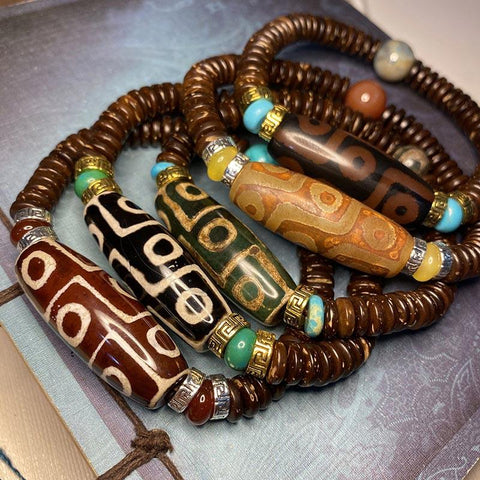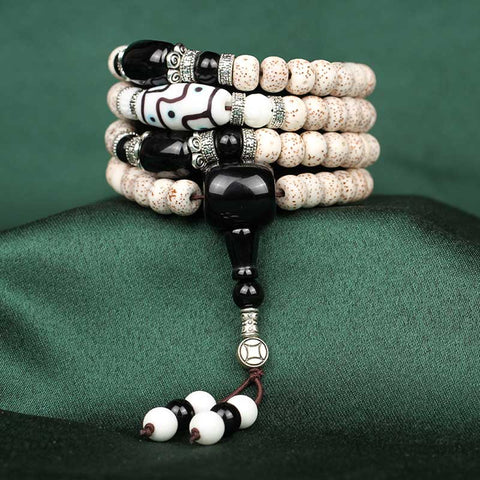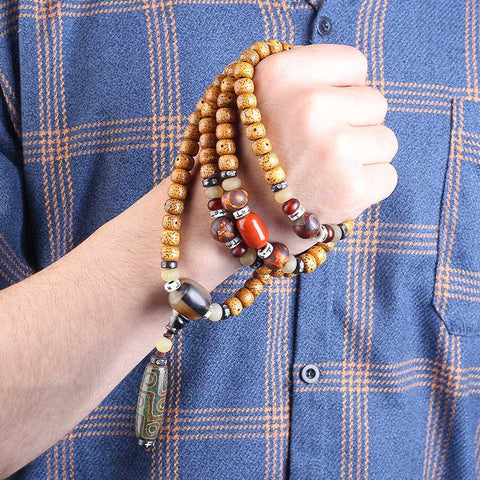Why Use Dzi Beads And How To Wear It?
Dzi Stones are among the most potent, valuable, and sought-after charms available. These beads are expensive. The Dzi are spiritual relics for many Tibetans, and the stones are often handed down to the next generation. The genuine Dzi Beads, as per Tibetan medical records, can boost immune efficiency and avert apoplexy. However, the number of genuine Dzi Beads is limited and extremely rare.
It is critical to wash the Dzi stone as soon as you get it. It is necessary to release all of its stored energy before asking it to unite with you. You will read more about Dzi beads meaning in the following section.
What is Dzi Bead?
These beads are a kind of stone bead with an unidentified source that is utilized as an element of a chain or bracelet. Dzi (called Zee) is a Tibetan term for a patterned agate, rectangular, circular, tubular, or columnar shape perforated longitudinally and known in Chinese as heaven's Beads (tianzhu).
The Tibetan term Dzi means bright, light, clarity, or splendor in English. The pearls are from Tibet's cultural domain and can fetch luck. They're hard to come by. They are predominantly present in Tibet and Sikkim.
The beads are often used as beneficial amulets and converted into dust for use in Tibetan healing. The bead has been chipped or crushed away to be used in the medicine, leaving dig scars on the bead.
The most valuable Dzi stones are those fashioned of genuine agate and dating back thousands of years. Researchers still don't know anything about the origin of these beads. While Tibetans favor the original, ancient-style stones, the modern-made dzi is becoming increasingly popular.
Older beads can easily fetch thousands of dollars on the market, especially if they have eyes. Tiny crimson stains on the agate generated by iron inclusions add to its value. The cost of a new dzi varies between ten - two thousand dollars, based on the quality and brilliance.
Origin and History of Dzi Beads
Dzi stones initially appeared in medieval India around 2000 to 1000 BC, when Tibetan warriors allegedly recovered a few from Persia following a battle. These people were highly concerned about the evil eye's destructive effect. Dzi was said to be able to ward off the evil eye. Agate was utilized as the basic stone, and the beads were then adorned with shapes utilizing old yet unknown procedures.
Even though the source of Dzi beads is unknown, they are currently known as Tibetan beads. Tibetans hold these beads in high regard and believe them to be hereditary jewels. They have endured hundreds of years in this manner, being worn by many people.
Design of Dzi Beads
Dzi stones are constructed of agate and may feature decorative motifs like spheres, ovals, triangles, lines, diamonds, and other classic or symbolic designs. The pattern is often creamy white, and the colors span from dark to black. Dzi beads come in different sizes and colors, and their surfaces are smooth and glossy, indicating that they have been worn over time.

The original agate designs can be seen beneath or behind the ornate symbols and decorations, and sometimes they can't. Blood spots, which are red in white regions indicating iron concentration, can be found on such Dzi beads.
Meaning and Healing Properties of Dzi Beads
As previously stated, dZi pearls are primarily employed for protection, although their diverse marks can confer other qualities. Some will safeguard the user from mishaps, others will bring affection, and others will provide a comfortable existence. The dZi motifs, and their meanings, are listed in great detail.
You should clean the beats daily and receive the therapeutic and inherent advantages. They are highly reactive to their environment and can collect negative vibes, which can be cleared by simply holding the stones underwater or smudging them with sage.
There are several dZi agate pearl collectors across the world. They are still in high demand in Tibet or other parts of Asia. New beads produced in the same style as the old dZi are famous and appear in bracelets or necklaces.
Tibetans thought that dZi stones were frozen bugs that were given as presents to persons with good luck. The dZi stones will provide great luck, prosperity, and fortune to the holder, and are a very safe item to use every day.
Types of Dzi Beads
DZI Beads come in a variety of shapes and sizes. The "eyes" are the most significant difference. The Dzi is being watched. Moreover, the role and significance are distinct. The quantity of eyes on the beads has a specific meaning and can help you improve elements of your life.
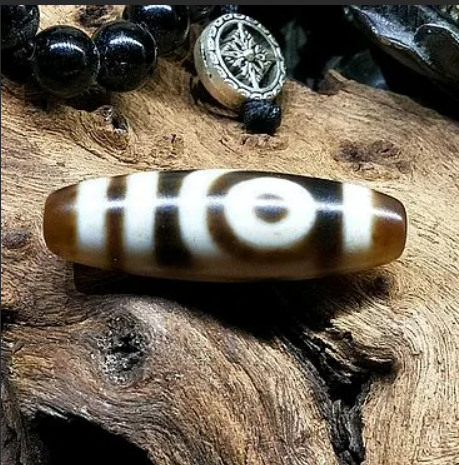
Several Dzi Beads are suitable selections for warding off negative energy among various beads - between 1 eyed and 21 eyed beads. They are as follows:
· The Dzi bead with one eye represents a ray of hope and brightness. Its powerful eye is said to increase human knowledge and introduce joy into life.
· The two-eyed Dzi promotes harmony between family members, a great family, a prosperous job, and strong interpersonal interactions.
· Fortune, happiness, and longevity are represented by the three eyes of the Dzi beads. It is the pearl of prosperity and health that will bring you good luck in the future.
· Detoxification and eliminating negativity using four-eyed beads.
· The five-eyed Dzi is regarded as a supernatural artifact in high demand. It is a highly valued bead since it aids in attaining everything one desires. There is no end to happiness.
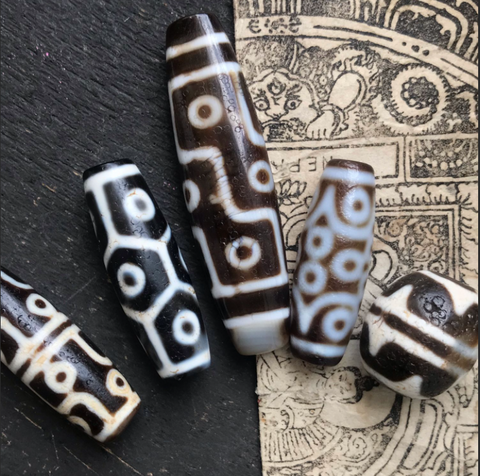
· The six-eyed Dzi removes misery and suffering from one's life and promotes one's access to good fortune.
· The 7-eyed Dzi assists in getting fame, building a career, healthy relationships, and improved health.
· Beads with eight eyes to guard against tragedy or calamity.
· Beads with nine eyes represent riches, health, strength, and protection
· Beads with 11 eyes to ward off evil intentions.
There are more beads, and they have different meanings. You can use fortunate stones or gems to boost the beneficial benefits of the Dzi Beads.
Feng Shui With Dzi Bead
A common Feng Shui sign of security and riches is the Dzi bead. It is a stone that emerged thousands of years ago in the Himalayan ranges. Many people use them for good fortune and fashion items, like a choker or Feng Shui bracelets.
Dzi Beads can be used as a protective symbol at homes in a clutter-free zone. They serve as amulets, protecting the user from harmful energy or injuries while attracting money, joy, and love.
In various eastern traditions, water is seen to be a spiritual cleanser. Before utilizing the Dzi stone, it is necessary to clean it with fresh water. After that, keep them in the sunlight for a few hours. It will help it become more energized and powerful.
The beads are rectangular or cylindrical in design, with circular designs or lines adorning them. Dzi beads are often used as pendants, bracelets, and necklace components. These are effective Feng Shui protective symbols.
How To Tell the Good Quality Dzi Beads
The beads will stay for many years if you take proper care. You must invest in good-quality beads. Take your time and do some research on the beads. Check to determine if any of the bead's signs, edges, eyes, or other features have been shattered. When the signs on a bead are broken, the bead is deemed broken. It is still regarded as functional if the symbols remain intact.
When a big section of a bead comes off, it is considered to have completed its task. It's time for the beads to resign and enjoy its retirement as a gift for all of its hard work.
Another option is to pick the one that they are most drawn to intuitively. Inquire of the innermost thoughts, and always believe your judgment and eyesight when it comes to determining what you require and which pearl appeals to you the most. Take nearly 30 seconds to consider that specific dzi and your feelings about it. Although Tibetans favor the old, ancient-style pearls, newer, modern-made dzi are getting popular.
How To Use Dzi Beads
If you have more than one bead, keep them in a protected and particular place when not in use, like a jewelry box or soft pouch. When using the stone, lightly brush the hands together to boost the stone's brilliance and color.
Wearing the Dzi pearls in water is not a good idea. Take the Dzi bead before washing or bathing, as it does not like moisture. You can't wear the Dzi bead in the pool if you're going for a swim. The chemicals in the water will damage the bead and diminish the color.
If you have a band, try not to get the Dzi beads wet because the moisture will weaken the threads and allow them to break quickly. Make sure that you never drop the Dzi beads. It will put a strain on the bead and may cause it to shatter.
If you guard the Dzi bead, it will defend you. Don't let anyone else borrow the beads or put them on or touch them.
How To Clean Dzi Beads
Take some Yushou salt and mix it in warm water. Immerse the Dzi Beads for at least one day in the water. You can immerse the Beads in the Yushu salt mix for thirty minutes once every week. While the Beads are resting in the mixture, lightly brush them with a tiny brush.
Every few days, clean the Dzi Bead with a clean towel to brush it off and eliminate oil and other foreign materials. When you immerse the Dzi Beads in the salt solution, hang them outside to dry naturally.
Do's and Don'ts With the Dzi Bead
When you wear it (on your wrist, neck, waist, leg, etc.), the Dzi Bead must touch the skin rather than your garments. It allows the Dzi Bead to merge with the natural atmosphere and energy of the body.
Remove it before indulging in any actions to show it respect. Do not wear the broken bead. If the bead gets broken, change it and wear the new one.
When having a bath, take off your Dzi Bead jewelry. While it's fine for the Dzi Pearls to come into touch with water, repeated exposure to water may cause the thread that keeps the Dzi Beads in bracelet shape to break.
What to do if the Dzi Bead is Broken?
Any pearl that has ripped off a piece of itself qualifies. It can be made into a tonic bead with a few tiny teeny cracks around the thread pores. A small hole or chip can be found everywhere on the bead. These can happen when the beads are in the fire for a long time. Because of the heating processes that the bead undergoes, these bits are liberated from the bead.
Medicines or potions will be made with these chips. Attaching valuable metal to the Dzi beads is another technique to keep wearing the damaged Dzi beads. Based on your existing scenario, you may change it with another dzi bead.
Note On Wearing the Dzi Beads
Please take the Dzi bead if you conduct behaviors that can be considered insulting to the Dzi bead. Please be very cautious when bathing or washing clothes, or even completing activities that can cause the Dzi beads to break if dropped or hit against anything. When not in use, the Dzi bead should be kept on the table to protect it from being damaged.
Sincere faith in the Dzi bead's ability to heal you is necessary. It will bring you insight and great luck. There are many types of beads available, and every bead has a meaning.
Conclusion
It's critical to wash the Dzi stone as soon as you get it. Keep the bead in a safe place. Leaving the beads can cause problems. So, store them in a box.
Despite their Tibetan roots, the Dzi beads can be used by anybody to promote a positive aura and positive karma. Since the beads have a legendary meaning rather than a spiritual one, the user's religion or ethnicity is irrelevant.
These are holy charms that have bestowed blessings on the user since ancient times. Due to the scarcity, they are becoming costly. They have a crucial position in the Tibetan tradition and are used in Tibetan medicine production.





